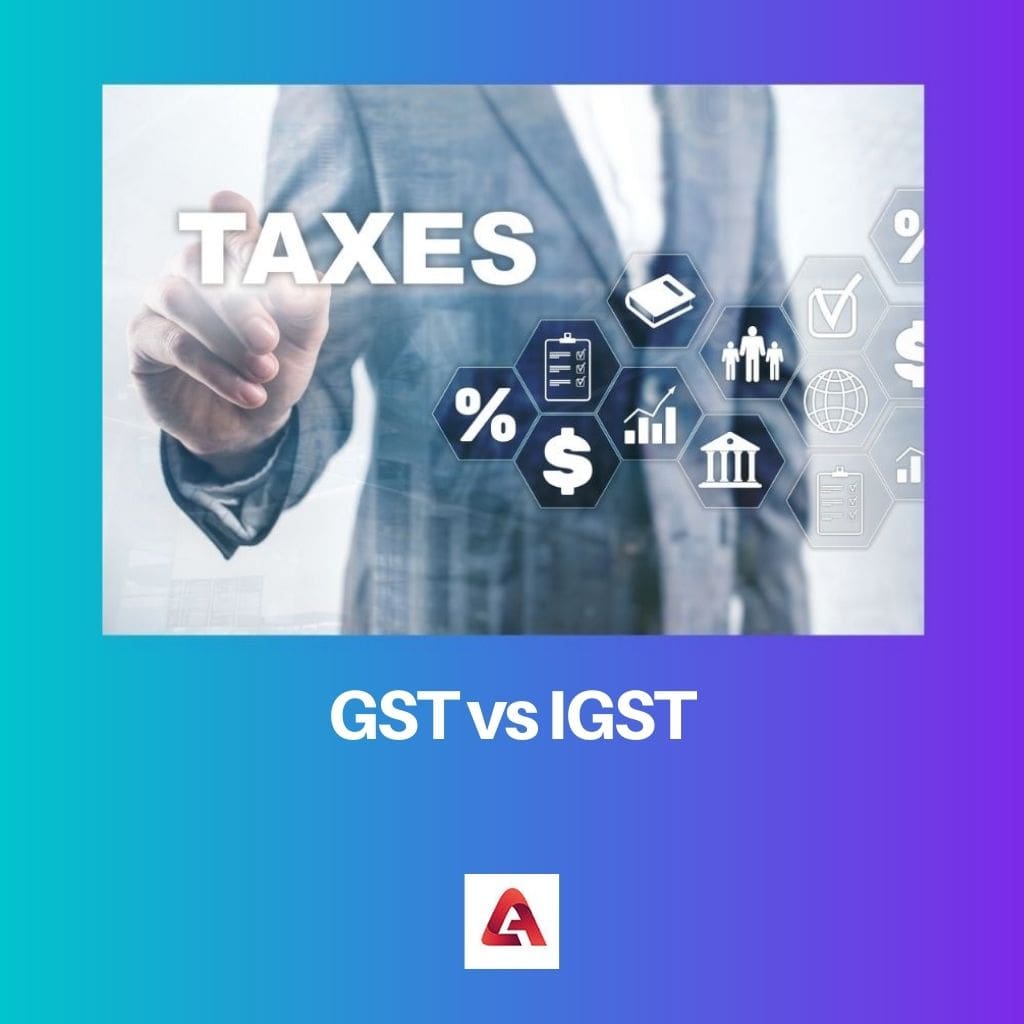GST (Goods and Services Tax) is a comprehensive indirect tax levied on the supply of goods and services within a country. IGST (Integrated Goods and Services Tax) is a component of GST applicable to interstate transactions. While GST is divided among the central and state governments, IGST is collected by the central government and then distributed to the respective states.
Key Takeaways
- Goods and Services Tax (GST) is a unified tax structure in India with three components: Central GST, State GST, and Integrated GST (IGST).
- IGST is a GST component charged on the inter-state supply of goods and services, facilitating equal distribution of tax revenue between the central and state governments.
- Both GST and IGST aim to simplify the tax system, but IGST specifically addresses taxation for interstate transactions.
GST vs IGST
The difference between GST and IGST is that GST is applied to any supply or delivery of any kind of goods or services. In contrast, IGST is a type of GST that the supplier must pay in case of the interstate supply of goods and services.

Dual vs. Single Taxation Point
- GST’s Dual Structure:
- GST operates with a dual structure, involving separate taxes levied by both the central and state governments. This dual taxation system is applicable to both intrastate and interstate transactions.
- IGST’s Singular Approach:
- In contrast, IGST adopts a single taxation point for interstate transactions. The central government collects IGST at the time of the transaction, simplifying the tax collection process for businesses engaged in interstate trade.
Handling Interstate Transactions
- GST’s Interstate Complexity:
- While GST encompasses both intrastate and interstate transactions, the complexity arises in interstate trade due to the involvement of multiple state taxes.
- IGST’s Tailored Solution:
- IGST is specifically designed to address the challenges posed by interstate transactions. It ensures a standardized tax treatment for goods and services moving across state borders, promoting ease of compliance for businesses.
Mechanism for Revenue Distribution
- GST’s Shared Revenue:
- GST revenue is distributed between the central and state governments based on predefined sharing mechanisms. Each state receives a designated share of the collected taxes.
- IGST’s Centralized Distribution:
- In the case of IGST, the central government collects the tax and subsequently distributes the funds to the respective states. This centralized approach streamlines the revenue-sharing process for interstate supplies.
Focus on Uniformity and Efficiency
- GST’s Comprehensive Objective:
- GST aims to create a uniform tax structure across the country, replacing various indirect taxes with a comprehensive system. It addresses the need for a simplified and standardized tax regime within individual states.
- IGST’s Precision for Interstate Trade:
- IGST, on the other hand, hones in on the challenges associated with interstate trade. By consolidating central and state taxes into a single IGST for interstate supplies, it ensures a seamless and fair taxation system for businesses operating across state borders.
Comparison Table
| Feature | GST | IGST |
|---|---|---|
| Full Form | Goods and Services Tax | Integrated Goods and Services Tax |
| Applicability | Intra-state supply of goods and services (within the same state) | Inter-state supply of goods and services (between different states) and imports |
| Leviable Authority | Central Government (CGST) and State Government (SGST) | Central Government (revenue shared equally with consuming state) |
| Rate | CGST rate + SGST rate (varies based on product or service) | Single rate applicable throughout India |
| Input Tax Credit (ITC) Availability | CGST credit can be used against CGST or IGST, SGST credit can be used against SGST or IGST | Credit can be used against CGST, SGST, or IGST |
| Filing of Returns | Separate CGST and SGST returns for intra-state transactions | Single IGST return for inter-state transactions and imports |
What is GST?
GST, or Goods and Services Tax, is a unified indirect tax system implemented to replace the complex and cascading tax structure prevalent in many countries. It was introduced to streamline the taxation of goods and services, fostering a more efficient and transparent tax regime.
Key Features
- One Nation, One Tax
- GST unifies various indirect taxes levied by the central and state governments, creating a single, comprehensive tax applicable throughout the country. This eliminates the cascading effect of taxes, promoting a more seamless and uniform taxation system.
- Multi-Stage and Destination-Based Tax
- GST operates on a multi-stage model, involving multiple stakeholders in the supply chain. It is a destination-based tax, meaning that the tax is levied at the final point of consumption. This ensures that the taxing authority of the consuming state receives revenue, fostering a balanced distribution of tax income among states.
- Taxation on Supply
- GST is levied on the supply of goods and services, encompassing manufacturing, trading, and service sectors. The term “supply” is comprehensive and covers all forms of transactions, including sale, transfer, barter, exchange, license, rental, lease, or disposal.
Components of GST
- CGST (Central Goods and Services Tax)
- Collected by the Central Government, CGST is applicable on intra-state transactions. The revenue generated from CGST goes to the central government.
- SGST (State Goods and Services Tax)
- Collected by the State Government, SGST is applicable on intra-state transactions. The revenue generated from SGST goes to the respective state government where the transaction takes place.
- IGST (Integrated Goods and Services Tax)
- Applicable to interstate transactions, IGST is collected by the Central Government. It ensures that the taxing authority of the consuming state receives revenue, promoting a cohesive and cooperative tax framework among states.
- UTGST (Union Territory Goods and Services Tax)
- Similar to SGST, UTGST is applicable to intra-union territory transactions. The revenue generated from UTGST goes to the respective union territory government.
Benefits of GST
- Simplified Tax Structure
- GST eliminates the complexities of multiple taxes and provides a standardized tax structure, making compliance easier for businesses.
- Boost to Economic Growth
- By promoting a more efficient and transparent tax system, GST contributes to economic growth, facilitating ease of doing business.
- Reduced Tax Evasion
- The transparent nature of GST, coupled with the use of technology, helps reduce tax evasion and ensures better compliance.

What is IGST?
Integrated Goods and Services Tax (IGST) is a crucial component of India’s Goods and Services Tax (GST) system, designed to streamline and unify indirect taxation across the country.
Jurisdiction and Applicability
- Interstate Transactions:
- IGST is applicable to transactions involving the movement of goods and services between different states in India.
- It eliminates the complexities associated with multiple state taxation systems by providing a single tax for interstate supplies.
Mechanism and Collection
- Single Taxation Point:
- The central government collects IGST at the time of the transaction.
- It operates on a destination-based principle, where the tax is levied based on the location of the consumer, ensuring revenue accrues to the state where the goods or services are consumed.
- Distribution of Revenue:
- The collected IGST is then divided between the central and respective state governments.
- The process ensures a seamless flow of funds and prevents tax cascading, contributing to a more efficient and transparent tax structure.
Advantages and Significance
- Uniformity and Simplification:
- IGST promotes uniformity in taxation by treating interstate transactions similarly to intrastate ones, fostering a simplified and consistent tax environment across the country.
- It reduces compliance burdens for businesses engaged in interstate trade.
- Prevention of Double Taxation:
- By consolidating both central and state taxes into IGST, the system prevents the occurrence of double taxation on interstate supplies, promoting a fair and integrated tax regime.

Main Differences Between GST and IGST
- Scope of Application:
- GST: Applicable to both intrastate (within the same state) and interstate (between different states) transactions.
- IGST: Specifically designed for interstate transactions, providing a unified tax for goods and services moving across state borders.
- Taxing Authority:
- GST: Involves separate taxes levied by both the central and state governments, with revenue distributed accordingly.
- IGST: Collected by the central government and then distributed to the concerned states, simplifying the taxation process for interstate supplies.
- Tax Collection Point:
- GST: Taxes are collected at both the central and state levels, leading to a dual taxation system.
- IGST: Operates on a single taxation point, with the central government collecting IGST at the time of the transaction for interstate supplies.
- Revenue Distribution:
- GST: Revenue is divided between the central and state governments based on predetermined sharing mechanisms.
- IGST: Collected funds are distributed between the central and respective state governments to ensure a fair share of revenue for both.
- Objective:
- GST: Aims to create a uniform tax structure across the country, replacing various indirect taxes with a comprehensive system.
- IGST: Specifically addresses the complexities of interstate trade, providing a standardized tax for businesses engaged in transactions across state borders.
- Prevention of Double Taxation:
- GST: May lead to the cascading effect of taxes, particularly in interstate transactions, without a centralized mechanism.
- IGST: Prevents double taxation by consolidating both central and state taxes into a single IGST for interstate supplies, promoting efficiency and fairness.

Similarities Between GST and IGST
GST (Goods and Services Tax) and IGST (Integrated Goods and Services Tax) share several commonalities, as they are integral components of India’s taxation system aimed at unifying indirect taxes. Both systems are part of the broader GST framework, seeking to streamline and simplify taxation across the country.
One significant similarity lies in their fundamental objective: both GST and IGST aim to create a more transparent, efficient, and uniform tax structure. They replace the complex web of diverse indirect taxes, creating a standardized approach to taxation that applies consistently across states. This move towards uniformity is especially notable in the case of IGST, as it specifically addresses challenges related to interstate transactions.
Furthermore, both GST and IGST contribute to the prevention of cascading taxation, where taxes are levied on top of already taxed amounts. This is achieved by integrating central and state taxes into a single tax point, whether it be through the dual taxation points in GST or the singular point in IGST. The overarching goal is to reduce compliance burdens for businesses, promote a seamless flow of goods and services, and eliminate the inefficiencies associated with the previous fragmented tax system.
- https://repository.up.ac.za/bitstream/handle/2263/32342/Cnossen_Preparing(2013).pdf?sequence=1
- https://books.google.com/books?hl=en&lr=&id=GoOWDwAAQBAJ&oi=fnd&pg=PA60&dq=GST+and+IGST&ots=Krh1okeW_z&sig=WU5tXiRMETdb34MmQlxh3n5a5dQ

The advantages and disadvantages of GST and IGST are explored thoroughly in this post. It’s certainly an important and timely topic in the current financial landscape of India.
Indeed, Matthew. The post doesn’t shy away from acknowledging the complexities and potential drawbacks of these tax systems.
What a detailed and well-constructed comparison between GST and IGST. The information presented will unquestionably help individuals grasp the nuances of these tax systems.
I agree, Joanne. This post managed to make what can be complex topics like this accessible to the average reader.
The comparison table provided is incredibly helpful. It succinctly highlights the key differences and implications of both GST and IGST.
The implications and importance of GST and IGST are very thoughtfully illustrated here. It’s evident that the government’s intention is to reduce complexity and administrative burden while promoting equal distribution of tax revenue.
I also found the clarity provided on what GST aims to end extremely beneficial. The post aptly explores the problems that GST seeks to eliminate.
Absolutely. I appreciate how the post highlights the advantages and disadvantages of both systems, providing a balanced view for readers to evaluate.
What a comprehensive and informative explanation of GST and IGST! I truly believe that this system will lead to making the tax process simpler and more transparent, ultimately benefiting the Indian business sector.
I couldn’t agree more. The post provides a clear and detailed comparison between GST and IGST, leaving no room for confusion.
The detailed comparison table and lucid explanation of GST and IGST’s implications make this post a worthwhile read. Certainly an important resource for anyone seeking to comprehend these tax systems.
I couldn’t agree more, Nikki. The distinctive attention to detail in the post is truly praiseworthy.
Absolutely, Nikki. The meticulousness with which the post articulates these topics is undeniably impressive.
The lucidity with which the post lays out the difference between GST and IGST is truly impressive. This will undoubtedly serve as a valuable resource for readers seeking to understand these systems better.
I couldn’t agree more, Logan. The post’s treatment of the topic is both thorough and accessible.
Absolutely, Logan. The post explores the complexities and nuances of these systems with clarity and precision.
This post manages to present the intricate details of GST and IGST in a highly engaging way. The insights and analysis are truly commendable.
The clarity with which the post distinguishes between GST and IGST is remarkable. It’s an important resource for anyone seeking a thorough understanding of the topic.
I fully agree, Scott. The post provides a comprehensive understanding of the mechanics of these tax systems.
To gain such a thorough understanding of GST and IGST from a single source is commendable. I found the post incredibly informative and valuable.
The advantages and disadvantages of GST and IGST are presented in an objective and informative manner. This post certainly provides a valuable understanding of these systems.
I agree with you, Dave. The post’s clarity and depth of analysis are truly commendable.
The post’s detailed comparison between GST and IGST is truly enlightening. This level of insight is precisely what is needed on such complex topics.
Undoubtedly, Ben. The comprehensive breakdown of these systems provides significant value for readers.